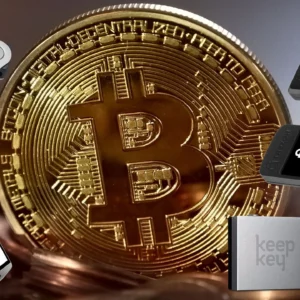The financial industry is on the verge of a significant transformation as Bank of America takes a bold step into the world of digital assets. The banking giant is reportedly developing a USD-Pegged Crypto Stablecoin, a move that could revolutionize finance by bridging traditional banking with blockchain technology.
As stablecoins gain traction as a reliable digital alternative to fiat currency, Bank of America’s entry into this space signals a major shift in the way financial institutions approach digital payments and blockchain-based transactions.
In this blog post, we’ll explore the key aspects of this development, including what a USD-pegged stablecoin is, why Bank of America is investing in crypto, the potential impact on global finance, and what it means for everyday consumers and businesses.

Understanding USD-Pegged Crypto Stablecoins
A USD-pegged crypto stablecoin is a type of digital asset designed to maintain a stable value by being backed by the US dollar or equivalent assets. Unlike traditional cryptocurrencies such as Bitcoin and Ethereum, which experience high volatility, stablecoins offer price stability, making them ideal for payments, remittances, and trading.
Bank of America’s proposed USD-pegged crypto stablecoin will likely function as a bridge between traditional banking and decentralized finance (DeFi). It could provide customers with a seamless digital payment solution, enabling instant transactions with reduced costs compared to traditional banking methods.
Stablecoins generally fall into three categories:
- Fiat-backed stablecoins (backed by real currency in a 1:1 ratio, like USDC and USDT)
- Crypto-backed stablecoins (collateralized by other cryptocurrencies)
- Algorithmic stablecoins (stabilized through smart contract mechanisms)
Given Bank of America’s established presence in traditional finance, it is expected that their stablecoin will be fully backed by fiat reserves, ensuring trust and regulatory compliance. This could set a new standard for stablecoin legitimacy within the financial sector.
Why is Bank of America Entering the Stablecoin Market?
The decision by Bank of America to revolutionize finance with a USD-pegged crypto stablecoin stems from the increasing adoption of blockchain technology and the demand for more efficient financial transactions. There are several key reasons why the banking giant is taking this step:
1. Growing Popularity of Stablecoins
The global market for stablecoins has surged in recent years, with billions of dollars in circulation. Companies like Tether (USDT) and Circle (USDC) have led the way, proving that stablecoins are a viable financial instrument. Bank of America recognizes this trend and wants to establish itself as a trusted provider in this evolving space.
2. Enhancing Cross-Border Payments
Traditional cross-border transactions can be slow and expensive due to intermediaries, exchange rate fluctuations, and banking fees. A USD-pegged crypto stablecoin issued by Bank of America could streamline international payments, making them faster, cheaper, and more accessible.
3. Regulatory Compliance and Institutional Trust
Unlike decentralized stablecoins, which often operate in regulatory gray areas, Bank of America’s involvement ensures a more compliant and trustworthy alternative. The bank is well-positioned to revolutionize finance by introducing a stablecoin that meets regulatory standards, potentially gaining approval from institutions like the Federal Reserve and the SEC.
4. Competing with Fintech and Crypto Companies
With the rise of fintech giants like PayPal and crypto-native firms like Circle offering stablecoins, traditional banks are under pressure to innovate. By launching a stablecoin, Bank of America can compete directly with digital payment platforms while retaining its massive customer base.
How Bank of America’s Stablecoin Could Revolutionize Finance
The introduction of a USD-pegged crypto stablecoin by Bank of America has the potential to reshape the financial industry in several profound ways.
1. Bridging Traditional Banking and Blockchain
One of the most significant barriers to mainstream crypto adoption has been the lack of trust and security in decentralized platforms. A stablecoin backed by Bank of America could serve as a bridge between traditional banking and the digital asset economy, allowing users to transact with confidence.
2. Enhancing Financial Inclusion
Millions of people worldwide lack access to traditional banking services. A USD-pegged crypto stablecoin could enable financial inclusion by providing individuals with a low-cost, digital means of storing and transferring value, regardless of geographic location.
3. Improving Transparency and Security
Unlike some stablecoins that have faced scrutiny over reserve transparency, a Bank of America-backed stablecoin would likely adhere to strict regulatory and auditing requirements. This could help set a new industry standard for transparency and consumer protection.
4. Boosting Institutional Adoption of Crypto
Many institutional investors have been hesitant to adopt crypto due to concerns about volatility and regulatory uncertainty. A USD-pegged crypto stablecoin from a leading bank could encourage institutional participation, paving the way for broader digital asset adoption.
Potential Challenges and Risks
While Bank of America’s stablecoin has the potential to revolutionize finance, there are several challenges and risks to consider.
1. Regulatory Hurdles
The cryptocurrency space is heavily scrutinized by regulators. Bank of America will need to navigate complex regulations from entities such as the SEC, CFTC, and Federal Reserve to ensure compliance.
2. Competition from Existing Stablecoins
Tether (USDT), USD Coin (USDC), and PayPal’s PYUSD already dominate the stablecoin market. Bank of America will need to offer unique advantages to differentiate its stablecoin.
3. Adoption and Integration
For the stablecoin to be successful, it must be widely adopted by merchants, payment processors, and financial institutions. The bank will need to invest in partnerships and infrastructure to ensure seamless integration.
4. Cybersecurity Risks
As a digital asset, stablecoins are vulnerable to cyber threats, including hacking and fraud. Bank of America must implement robust security measures to protect user funds and ensure system integrity.
Conclusion: A New Era for Finance?
The launch of a USD-pegged crypto stablecoin by Bank of America has the potential to revolutionize finance, offering a secure, regulated, and efficient alternative to traditional banking transactions. With the ability to enhance cross-border payments, promote financial inclusion, and drive institutional crypto adoption, this stablecoin could set a new precedent in the financial industry.
However, challenges such as regulatory approval, competition, and cybersecurity risks must be addressed to ensure a successful rollout. If Bank of America manages to overcome these obstacles, it could play a pivotal role in the future of digital finance.
What do you think about Bank of America entering the stablecoin market? Could this be a game-changer for the financial industry? Let us know your thoughts in the comments below!






